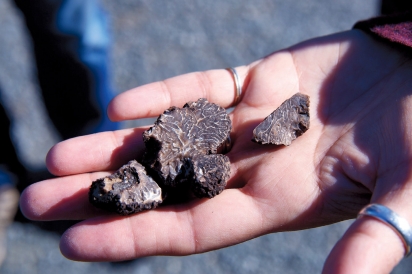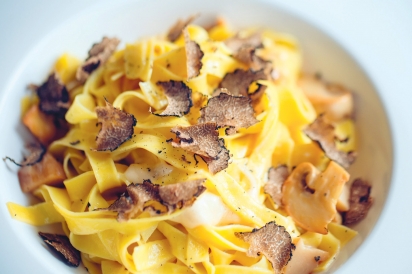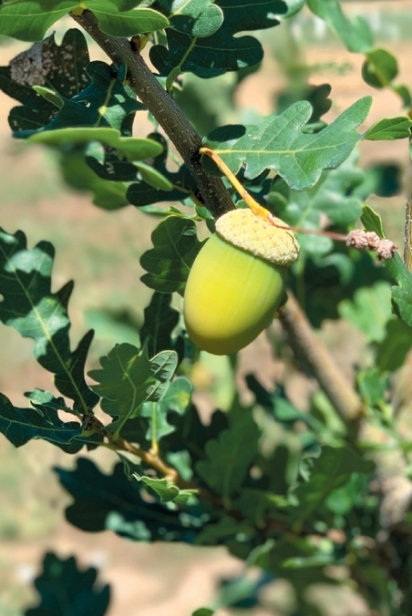Not Your Average Retirement Plan
BETTING ON TRUFFLES
Fabrice Caporal’s retirement plan is unusual, to say the least. To call it audacious would be a vast understatement.
The Alameda software engineer with a wife and two teenage children didn’t sink his million-dollar life savings into tech stocks or mutual funds, but into 26 acres of dirt. This past spring, Caporal planted 3,600 oak trees on his Lake County property, creating what is, according to my research, the largest Perigord truffle orchard in California. The trees, the roots of which have been inoculated with the spores of one of the world’s finickiest and most prized luxury ingredients, could start producing the “black gold,” aka truffles, in five to seven years. Or never at all.
“It’s a big gamble. There’s a lot of uncertainty. And it’s scary,” he says. “But I think it’s worthwhile.”
So do others who have fallen under the spell of the intoxicatingly fragrant, extremely perishable and rare wild fungus that fetches more than $1,000 per pound on world markets. So much so that they’ve made major investments to attempt to cultivate truffles by planting orchards of inoculated oak or hazelnut trees, tree species upon whose roots truffles naturally grow.
Perigord truffles are native to the Perigord region of France, hence their name, not North America. In stepped Oregon’s New World Truffieres, which has helped to establish more than 50 truffle orchards in California, each at least a half-acre in size. Last year, half of the company’s plantings were in Northern California, with an uptick in interest particularly in the Sonoma and Mendocino county regions, according to New World Truffieres’ founder Charles Lefevre. Of the 12 known productive commercial truffle orchards in the United States (those that sell what they harvest), 11 of them are planted with Lefevre’s trees. Caporal, who purchased his trees from Lefevre, hopes to add his property to that number some day.
Competitor American Truffle Company, based in San Mateo and the United Kingdom, has established between one and two dozen truffle orchards in the state, with the majority in the Napa and Sonoma regions, says its managing director Robert Chang, who declined to specify the exact number. Some are newly planted; others as old as eight years. Chang says he is also fielding four times the number of inquiries he did five years ago.
Interest is only expected to grow, sparked greatly by the news that Jackson Family Wines harvested the first cultivated Perigords in the Bay Area in 2017 at its 10-acre Santa Rosa orchard planted in 2009 with Lefevre’s trees. That first harvest netted 17 black truffles. The following season, not only were more than 30 pounds harvested, but the truffles were growing in many more areas of the orchard.
As director of the culinary gardens at Jackson Family Wines, Tucker Taylor has grown his share of unusual edibles, including oyster leaf from the moors of Scotland, ice lettuce from coastal Africa and myoga (ginger) from Japan. But this was definitely a highlight.
“Introducing black truffles is special,” he says. “It pushes us to think, innovate and cultivate new opportunities. Every season, we learn more and more.”
In December 2018, truffles also were discovered at the three-acre Sonoma County orchard owned by Sandy Otellini, widow of former Intel CEO Paul Otellini, which had been planted seven years earlier. The first one, sniffed out by a specially trained dog, was 108 grams and the size of a baseball. Otellini popped open a bottle of Champagne, and immediately summoned Chang, who had sold her the inoculated trees, and Chef Ken Frank of Napa’s Michelin-starred La Toque, who cooked a special pasta on the spot with half the truffle shaved overtop.
“When I saw the truffle, there was a huge sense of relief and excitement,” says Chang about the first Perigord harvested in North America from his company’s trees. “We know the science works. But the waiting game has always been tough. Now that we have the first one, it’s validated everything we’ve done.”
The Napa Truffle Festival, founded by the American Truffle Company, will celebrate its 10th anniversary this January. The event, which features how-to seminars and lavish truffle dinners, sells out regularly. This year for the first time festival organizers plans to spotlight homegrown truffles—those from the Otellini orchard.
Others getting in on the truffle game include vineyard owners Robert Sinskey, who has devoted 1½ acres on the edge of his Sonoma property, and brothers Todd and Trevor Traina, who have planted 2½ acres in the Napa Valley’s Stag’s Leap District to inoculated trees.
Why is Wine Country so suitable for this endeavor? One reason is the region’s temperate climate, which is similar to Southern Europe, where Perigords flourish in the wild. Another is that vineyard owners already have the built-in infrastructure necessary—land, equipment and agricultural workers. Cultivating truffles is also a less expensive undertaking than winemaking, making it an interesting “side bet.” It costs about $14,000 an acre to plant a truffle orchard, Lefevre says, plus another $2,500 annually to maintain it. In contrast, growing wine grapes would cost more than twice as much. Last but not least, truffles can be much more profitable, reaping five times what the same acre of grapes might bring, when sold commercially.
“We’re still in the pioneering stage of this industry. We haven’t even reached the early-adopter stage yet,” says Lefevre, who started the Oregon Truffle Festival 15 years ago, the first of its kind in the United States. “It will take decades, but this industry will flourish. It is not a flash in the pan.”
That is what Caporal is counting on. The 53-year-old native of France, who studied marine biology, may not come from a farming background, but his mother once owned a truffle orchard in Avignon. That’s what got him curious about whether he could grow Perigords in California. When he first told his wife what he wanted to do, he feared she would think he was going through a midlife crisis. But she was all in.
“When your husband comes up with an idea and he’s passionate about it, it’s very sexy,” says Mexican-born Claudia Medina, 48, who met Caporal when they were students at San Francisco State University. “You can’t help but get behind it, especially because I am at an age in my life where I can still get on my knees, and work hard by pulling weed after weed, tree by tree.”
That is exactly what they do, along with their 16-year-old son Dorian and 18-year-old daughter Océane. The family tends the organic orchard, dubbed Clos Racines for “vineyard of roots,” on their own with assistance from one contractor who helps trap gophers, which have already done major damage by destroying 80 of the trees. Since January, more than 1,000 gophers have been caught on the property, a former pear orchard with its own wells that was initially cleared by a previous owner to make way for a vineyard that never materialized.
In a nod to his tech background, Caporal has installed bar codes on all the trees, some of which have already grown to more than seven feet tall. Several times a week he makes the three-hour drive to visit the orchard, where he tracks its progress, awaits its potential patiently and remains ever so optimistic through it all.
“There is joy in the science and in figuring things out,” Medina says. “It would be heartbreaking if this didn’t work out. But I mean it when I say that I am enjoying the ride.”









